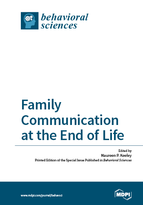Family Communication at the End of Life
A special issue of Behavioral Sciences (ISSN 2076-328X).
Deadline for manuscript submissions: closed (28 February 2017) | Viewed by 130012
Special Issue Editor
Special Issue Information
Dear Colleagues,
End of life communication (EOL) includes both verbal and nonverbal messages that transpire between a diagnosis of a terminal illness and death. The circumstances that occur at the end of life create opportunities for unique and important communication, especially for family members. Specifically, communication at the end of life is impacted by numerous and complicated factors that we are hoping to highlight in this Special Issue exploring “Family Communication at the End of Life.” Some of the potential areas include:
- Cultural views on death and dying as they impact family commuication at the EOL (i.e., what is talked about, when it can be talked about, and who is included in the family conversations).
- Family communication at the EOL from the terminally ill person’s perspective.
- Family communication at the EOL between life partners.
- Family commuiction at the EOL with children and adolescents.
- Interactions with healthcare professionals (preferably with palliative care specialists) with both the terminally ill and family members (i.e., EOL decision making, comfort care, degrees of openness, etc.).
- Family communication with professional care givers and hospice volunteers
- Family communication at the end of life and the use of technology.
- Methodological considerations regarding Family Communication at the EOL.
- Multi-disciplinary perpectives on EOL communication within the family.
- Backstage conversations surrounding communication amongst other family members.
- Family Communication in the midst of sudden and unexpected deaths.
Prof. Dr. Maureen P. Keeley
Guest Editor
Manuscript Submission Information
Manuscripts should be submitted online at www.mdpi.com by registering and logging in to this website. Once you are registered, click here to go to the submission form. Manuscripts can be submitted until the deadline. All submissions that pass pre-check are peer-reviewed. Accepted papers will be published continuously in the journal (as soon as accepted) and will be listed together on the special issue website. Research articles, review articles as well as short communications are invited. For planned papers, a title and short abstract (about 100 words) can be sent to the Editorial Office for announcement on this website.
Submitted manuscripts should not have been published previously, nor be under consideration for publication elsewhere (except conference proceedings papers). All manuscripts are thoroughly refereed through a single-blind peer-review process. A guide for authors and other relevant information for submission of manuscripts is available on the Instructions for Authors page. Behavioral Sciences is an international peer-reviewed open access monthly journal published by MDPI.
Please visit the Instructions for Authors page before submitting a manuscript. The Article Processing Charge (APC) for publication in this open access journal is 2200 CHF (Swiss Francs). Submitted papers should be well formatted and use good English. Authors may use MDPI's English editing service prior to publication or during author revisions.
Keywords
- End of life communication
- Final conversations
- Family communication
- Bereavement
- Death
- Dying







